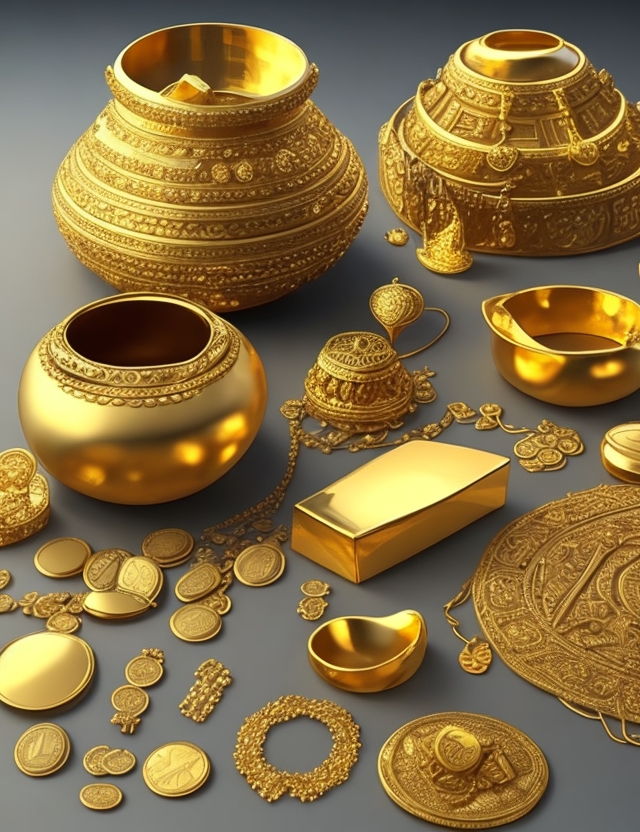I. Introduction
Gold has long been a symbol of wealth and value, prized for its rarity, beauty, and resistance to corrosion. From ancient civilizations to modern monetary systems, gold has played a crucial role in shaping human history and the global economy. In this article, we will explore the history of gold and how its value has changed over time.
II. Ancient Times
A. Early uses of gold in jewelry and religious ceremonies
Gold’s first known use dates back to around 4000 B.C. when it was crafted into ornamental objects and jewelry. Its lustrous appearance and resistance to tarnishing made it the perfect material for religious artifacts and burial items, signifying power and immortality.
B. The use of gold as a currency by ancient civilizations
As early as 700 B.C., the Lydians in modern-day Turkey began minting gold coins, marking the beginning of gold’s role as a currency. Gold’s durability, portability, and scarcity made it a convenient and reliable medium of exchange for ancient civilizations.
C. The role of gold in the rise of empires and the spread of trade
Throughout history, the possession and control of gold played a crucial role in the rise and fall of empires. Gold facilitated trade between regions, making it an essential resource for the growth and expansion of powerful civilizations like the Romans and the Incas.
III. The Gold Standard
A. The establishment of the gold standard in the 19th century
In the 19th century, the gold standard emerged as a global monetary system. This system pegged the value of a nation’s currency to a fixed amount of gold, which facilitated international trade and promoted economic stability.
B. The role of gold in international finance and trade
Under the gold standard, countries maintained gold reserves to back their currencies, ensuring their stability and exchangeability. This system streamlined international trade and finance, as currencies were easily convertible into gold at a fixed rate.
C. The impact of the gold standard on economic stability and growth
While the gold standard provided a measure of stability and predictability, it also had its drawbacks. By tying currency values to gold, economic growth became dependent on the availability of the precious metal, leading to periodic scarcities and deflationary pressures.
IV. The Modern Era
A. The end of the gold standard and the rise of fiat currencies
The gold standard began to unravel during the early 20th century, as world wars and economic crises strained its effectiveness. By the 1970s, the system was fully abandoned, giving rise to fiat currencies, which are backed only by the trust in the issuing government.
B. The changing role of gold in investment portfolios
With the end of the gold standard, gold’s role in the global economy shifted. Today, investors often view gold as a hedge against inflation and financial instability, as well as an asset that can add diversification to their portfolios.
C. The impact of economic and political events on the price of gold
Gold prices are influenced by a variety of factors, including global economic conditions, geopolitical events, and market sentiment. As a result, gold prices often fluctuate in response to changes in interest rates, inflation, and political uncertainty.
V. The Future of Gold
A. Predictions for the future of gold as an investment and commodity
While it is impossible to predict the future with certainty, gold is likely to remain a valuable commodity and investment asset. Its enduring appeal as a store of value and a hedge against uncertainty will likely continue to drive demand.
B. The role of gold in an increasingly digital and global economy
As our world becomes more digital and interconnected, gold may find new roles within the global economy. For instance, gold-backed digital currencies could emerge as a response to concerns about the stability of fiat currencies.
C. The potential for new uses of gold in technology and industry
Gold’s unique properties make it a valuable material for various applications in technology and industry. Innovations and breakthroughs in these fields may uncover new and exciting uses for gold, further solidifying its status as a versatile and valuable commodity.
As you consider your own investment strategy, take the time to reflect on the history of gold and its enduring value. Think about how gold might fit into your portfolio and how it could help diversify your assets and protect against economic uncertainty. Whether you choose to invest in physical gold, gold-backed securities, or gold mining stocks, remember that the story of gold is a testament to its enduring appeal and potential for growth.


